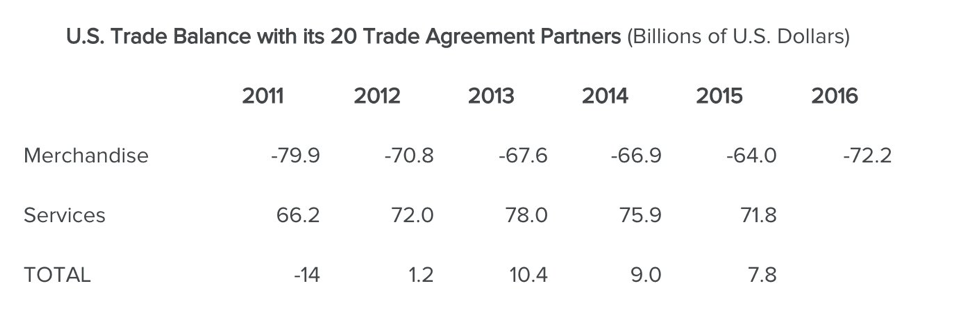NEWS
AmCham News tags
- Accounting / Financial
- AmCham Norway
- Company Profiles
- Education / Research
- Entertainment
- Food & Beverage
- Government
- Healthcare
- Hotel/ Restaurants/ Conferences
- Insurance
- International Leadership Interview Series
- Membership Guide
- Publications
- Rising Leaders
- Technology
- Trade
- Travel
Business News tags
- Accounting / Financial
- Airline / Travel
- Automobile / Transport
- Chemicals / Metals
- Communications/PR/Media
- Culture / Lifestyle
- Defense / Security
- Education / Research
- Energy
- Entertainment & Lifestyle
- Financial / Investment
- Food & Beverage
- Government
- Health
- Human Resources
- Insurance
- IP & Innovation
- Legal
- Management Consulting
- Manufacturing
- Pharmaceutical
- Politics
- Property / Real Estate
- Seafood
- Shipping & Offshore
- Statistics
- Tax
- Technology
- Trade
What Makes a Winning Trade Deal?
Category: Financial / Investment
As a new president and a new Congress settle in, this is a good moment to pause and reflect on America’s trade agreements. They’ve been front and center since last year’s election, and mostly as a matter of controversy.
But what does success look like when it comes to trade agreements? How can we measure their effectiveness? Here are a few questions and answers.
Do America’s trade agreements open up new markets effectively?
Yes. While our 20 trade agreement partners represent just 6% of the world’s population outside the United States, in recent years they have purchased nearly half of all U.S. exports, according to the U.S. Department of Commerce.
It should come as no surprise that eliminating tariffs and other trade barriers enables trade to expand—often turning small economies into major export markets. U.S. trade agreements have eliminated foreign duties on made-in-America products for more than 99% of all tariff lines as well as a host of non-tariff barriers.

Do they boost sales of made-in-USA goods and services around the globe?
Yes. U.S. exports to new trade agreement partner countries have grown roughly three times as rapidly on average in the five-year period following the agreement’s entry-into-force as the global rate of growth for U.S. exports, as Chamber research shows.
Sometimes they do a lot better than that: U.S. exports to Chile and Morocco quadrupled in the five years after U.S. trade agreements with those countries entered into force.

This boost to U.S. export growth is especially pronounced with more recent trade agreements, which are front-loaded to eliminate tariffs rapidly, open services markets, and eliminate nontariff barriers more comprehensively than earlier trade agreements.
Do our trade agreements make us wealthier?
Yes. International trade has raised the average U.S. household’s annual income by more than $13,600. Studies show that consumer gains stemming from trade disproportionately accrue to the poor and middle classes.
Looked at another way, U.S. trade barriers hit the poor hardest, which makes trade liberalization particularly beneficial to low-income Americans. As a paper from Progressive Economy explains:
Because U.S. tariffs are concentrated in taxation of cheap clothes, shoes, and other home goods rarely made in the United States, they are mostly ineffective as import limits and regressive as taxation. The main effect of reducing these tariffs through trade agreements would be to raise living standards for lower-income households and thus ease inequality.
Academic researchers recently found that “trade typically favors the poor, who concentrate spending in more traded sectors.” They find “a pro-poor bias of trade in every country … while high-income individuals consume relatively more services, which are among the least traded sectors.”
Do trade agreements lead to more balanced trade?
The bilateral trade balance is a poor measure of whether or not a trade agreement is successful, as the Chamber and many economists have explained in detail. But looking at trade in goods and services for each of the past four years (2011-2015), the United States has had a modest trade surplus with its 20 trade agreement partners as a group. (2016 services trade data won’t be available until the fall, so we can’t make a complete assessment for last year.)

Do they create new jobs? Support good jobs over the long haul?
When unemployment is high, economists generally agree that the expanded trade fostered by trade agreements spurs job creation. But they also generally agree that the principal effect of freer trade on jobs—particularly in a period of low unemployment—is to alter gradually the mix of jobs available by creating more high-skill, high-wage jobs and fewer low-skill, low-wage jobs.
Indeed, there is abundant evidence that jobs tied to trade tend to pay better than those that are not. According to Commerce Department research, manufacturing jobs tied to exports pay wages that average 18% higher than those that are not. The same is true for business services (i.e., architecture, engineering, project management, software, and insurance), a sector that employs more than 20 million Americans and offers wages averaging 18% higher than those in manufacturing.
The Chamber commissioned a study entitled Opening Markets, Creating Jobs: Estimated U.S. Employment Effects of Trade with FTA Partners. The study examined U.S. trade agreements implemented with a total of 14 countries. It found the increased trade brought about by these trade agreements boosted U.S. output by more than $300 billion and in turn supported 5.4 million U.S. jobs.
In sum, it’s pretty clear America’s trade agreements have a winning record. Trade isn’t a panacea for our nation’s economic ills, but these kinds of agreements aren’t the problem: They’re part of the solution.
Source: US Chamber of Commerce
